car seat FIAT SEICENTO 2007 1.G Owner's Manual
[x] Cancel search | Manufacturer: FIAT, Model Year: 2007, Model line: SEICENTO, Model: FIAT SEICENTO 2007 1.GPages: 154, PDF Size: 3.68 MB
Page 58 of 154
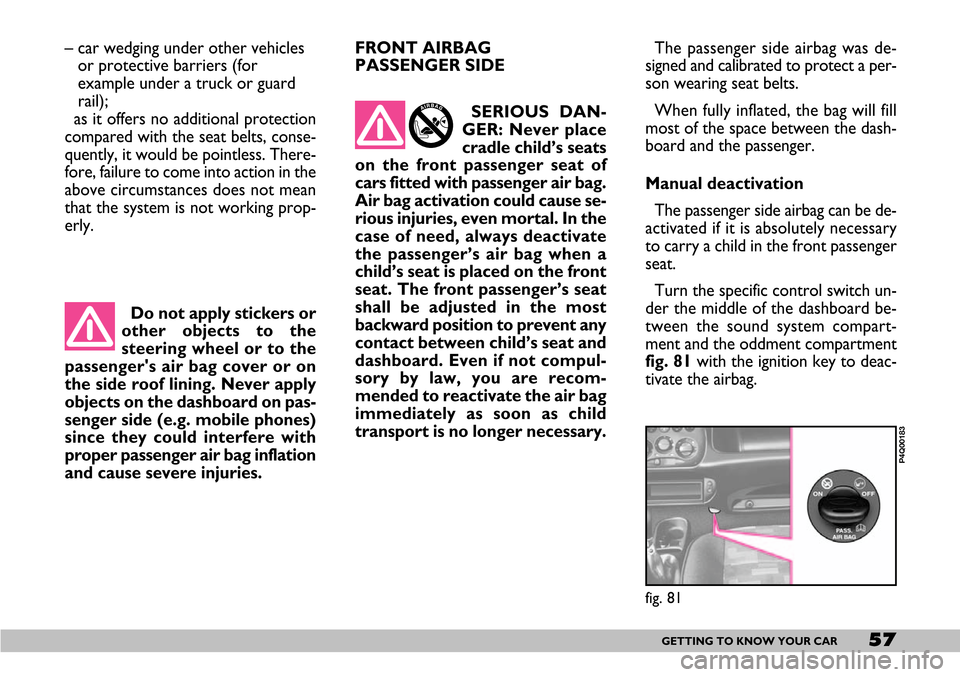
57GETTING TO KNOW YOUR CAR
Do not apply stickers or
other objects to the
steering wheel or to the
passenger's air bag cover or on
the side roof lining. Never apply
objects on the dashboard on pas-
senger side (e.g. mobile phones)
since they could interfere with
proper passenger air bag inflation
and cause severe injuries. – car wedging under other vehicles
or protective barriers (for
example under a truck or guard
rail);
as it offers no additional protection
compared with the seat belts, conse-
quently, it would be pointless. There-
fore, failure to come into action in the
above circumstances does not mean
that the system is not working prop-
erly.FRONT AIRBAG
PASSENGER SIDEThe passenger side airbag was de-
signed and calibrated to protect a per-
son wearing seat belts.
When fully inflated, the bag will fill
most of the space between the dash-
board and the passenger.
Manual deactivation
The passenger side airbag can be de-
activated if it is absolutely necessary
to carry a child in the front passenger
seat.
Turn the specific control switch un-
der the middle of the dashboard be-
tween the sound system compart-
ment and the oddment compartment
fig. 81with the ignition key to deac-
tivate the airbag. SERIOUS DAN-
GER: Never place
cradle child’s seats
on the front passenger seat of
cars fitted with passenger air bag.
Air bag activation could cause se-
rious injuries, even mortal. In the
case of need, always deactivate
the passenger’s air bag when a
child’s seat is placed on the front
seat. The front passenger’s seat
shall be adjusted in the most
backward position to prevent any
contact between child’s seat and
dashboard. Even if not compul-
sory by law, you are recom-
mended to reactivate the air bag
immediately as soon as child
transport is no longer necessary.
fig. 81
P4Q00183
Page 59 of 154
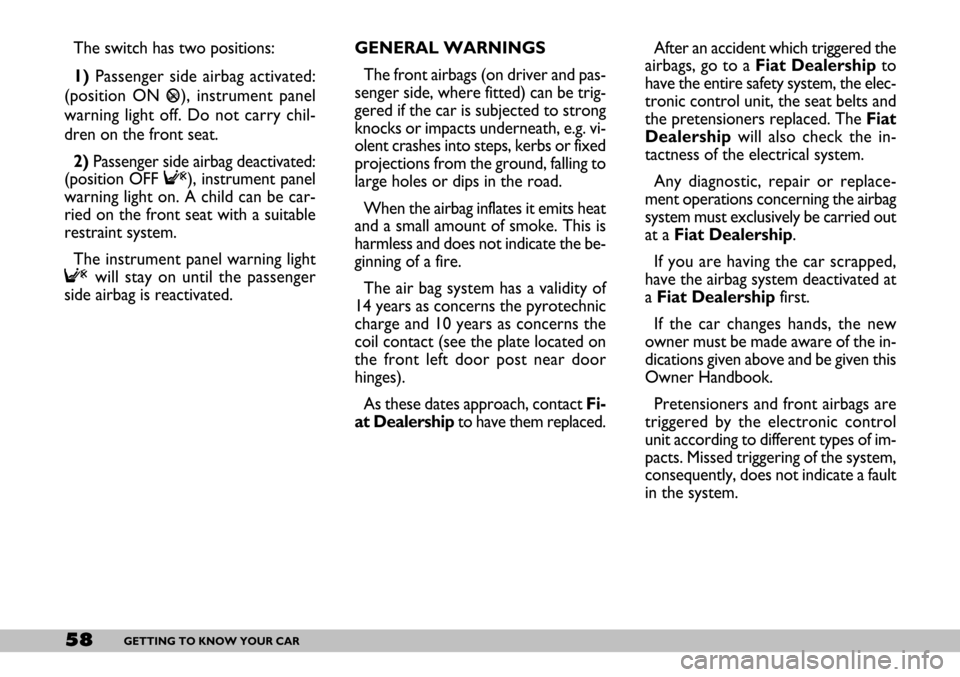
58GETTING TO KNOW YOUR CAR
The switch has two positions:
1) Passenger side airbag activated:
(position ON
P), instrument panel
warning light off. Do not carry chil-
dren on the front seat.
2)Passenger side airbag deactivated:
(position OFF F), instrument panel
warning light on. A child can be car-
ried on the front seat with a suitable
restraint system.
The instrument panel warning light
Fwill stay on until the passenger
side airbag is reactivated. GENERAL WARNINGS
The front airbags (on driver and pas-
senger side, where fitted) can be trig-
gered if the car is subjected to strong
knocks or impacts underneath, e.g. vi-
olent crashes into steps, kerbs or fixed
projections from the ground, falling to
large holes or dips in the road.
When the airbag inflates it emits heat
and a small amount of smoke. This is
harmless and does not indicate the be-
ginning of a fire.
The air bag system has a validity of
14 years as concerns the pyrotechnic
charge and 10 years as concerns the
coil contact (see the plate located on
the front left door post near door
hinges).
As these dates approach, contact Fi-
at Dealershipto have them replaced.After an accident which triggered the
airbags, go to a Fiat Dealershipto
have the entire safety system, the elec-
tronic control unit, the seat belts and
the pretensioners replaced. The Fiat
Dealershipwill also check the in-
tactness of the electrical system.
Any diagnostic, repair or replace-
ment operations concerning the airbag
system must exclusively be carried out
at a Fiat Dealership.
If you are having the car scrapped,
have the airbag system deactivated at
a Fiat Dealershipfirst.
If the car changes hands, the new
owner must be made aware of the in-
dications given above and be given this
Owner Handbook.
Pretensioners and front airbags are
triggered by the electronic control
unit according to different types of im-
pacts. Missed triggering of the system,
consequently, does not indicate a fault
in the system.
Page 60 of 154
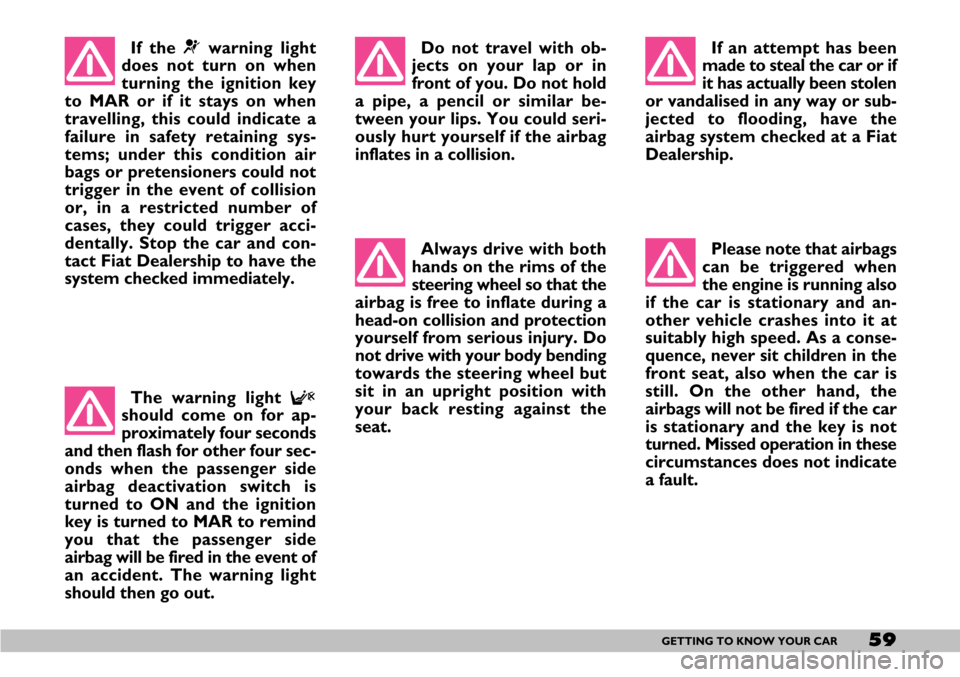
59GETTING TO KNOW YOUR CAR
If the ¬warning light
does not turn on when
turning the ignition key
to MAR or if it stays on when
travelling, this could indicate a
failure in safety retaining sys-
tems; under this condition air
bags or pretensioners could not
trigger in the event of collision
or, in a restricted number of
cases, they could trigger acci-
dentally. Stop the car and con-
tact Fiat Dealership to have the
system checked immediately. Do not travel with ob-
jects on your lap or in
front of you. Do not hold
a pipe, a pencil or similar be-
tween your lips. You could seri-
ously hurt yourself if the airbag
inflates in a collision.
The warning light
Fshould come on for ap-
proximately four seconds
and then flash for other four sec-
onds when the passenger side
airbag deactivation switch is
turned to ON and the ignition
key is turned to MAR to remind
you that the passenger side
airbag will be fired in the event of
an accident. The warning light
should then go out. Always drive with both
hands on the rims of the
steering wheel so that the
airbag is free to inflate during a
head-on collision and protection
yourself from serious injury. Do
not drive with your body bending
towards the steering wheel but
sit in an upright position with
your back resting against the
seat. If an attempt has been
made to steal the car or if
it has actually been stolen
or vandalised in any way or sub-
jected to flooding, have the
airbag system checked at a Fiat
Dealership.
Please note that airbags
can be triggered when
the engine is running also
if the car is stationary and an-
other vehicle crashes into it at
suitably high speed. As a conse-
quence, never sit children in the
front seat, also when the car is
still. On the other hand, the
airbags will not be fired if the car
is stationary and the key is not
turned. Missed operation in these
circumstances does not indicate
a fault.
Page 61 of 154
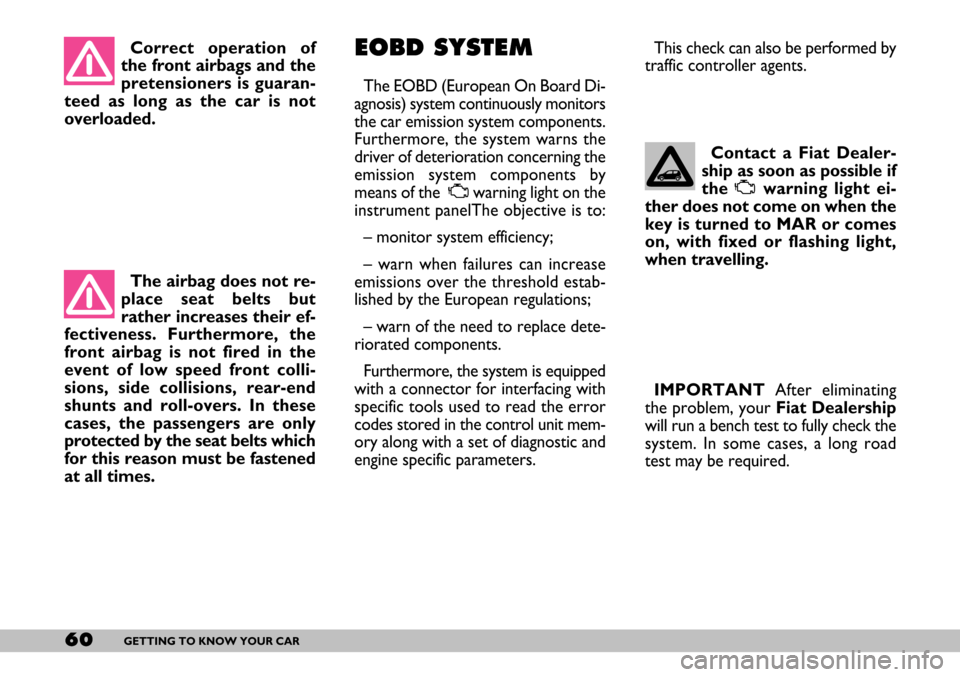
60GETTING TO KNOW YOUR CAR
Correct operation of
the front airbags and the
pretensioners is guaran-
teed as long as the car is not
overloaded.
The airbag does not re-
place seat belts but
rather increases their ef-
fectiveness. Furthermore, the
front airbag is not fired in the
event of low speed front colli-
sions, side collisions, rear-end
shunts and roll-overs. In these
cases, the passengers are only
protected by the seat belts which
for this reason must be fastened
at all times. EOBD SYSTEM
The EOBD (European On Board Di-
agnosis) system continuously monitors
the car emission system components.
Furthermore, the system warns the
driver of deterioration concerning the
emission system components by
means of the Uwarning light on the
instrument panelThe objective is to:
– monitor system efficiency;
– warn when failures can increase
emissions over the threshold estab-
lished by the European regulations;
– warn of the need to replace dete-
riorated components.
Furthermore, the system is equipped
with a connector for interfacing with
specific tools used to read the error
codes stored in the control unit mem-
ory along with a set of diagnostic and
engine specific parameters. This check can also be performed by
traffic controller agents.
Contact a Fiat Dealer-
ship as soon as possible if
the Uwarning light ei-
ther does not come on when the
key is turned to MAR or comes
on, with fixed or flashing light,
when travelling.
IMPORTANTAfter eliminating
the problem, your Fiat Dealership
will run a bench test to fully check the
system. In some cases, a long road
test may be required.
Page 63 of 154
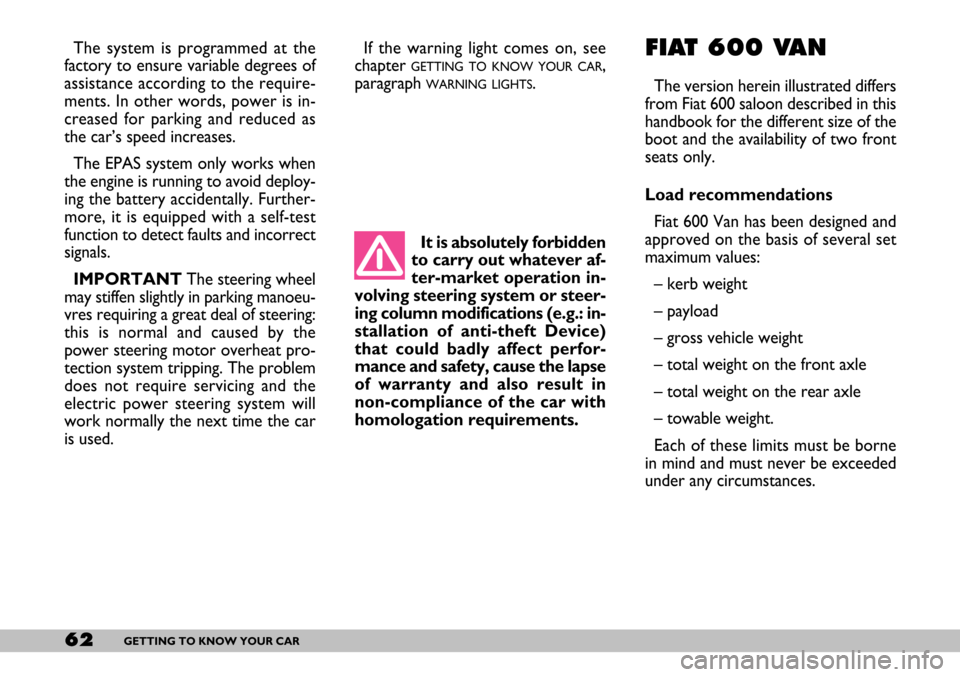
62GETTING TO KNOW YOUR CAR
The system is programmed at the
factory to ensure variable degrees of
assistance according to the require-
ments. In other words, power is in-
creased for parking and reduced as
the car’s speed increases.
The EPAS system only works when
the engine is running to avoid deploy-
ing the battery accidentally. Further-
more, it is equipped with a self-test
function to detect faults and incorrect
signals.
IMPORTANTThe steering wheel
may stiffen slightly in parking manoeu-
vres requiring a great deal of steering:
this is normal and caused by the
power steering motor overheat pro-
tection system tripping. The problem
does not require servicing and the
electric power steering system will
work normally the next time the car
is used.If the warning light comes on, see
chapter
GETTING TO KNOW YOUR CAR,
paragraph
WARNING LIGHTS.
FIAT 600 VAN
The version herein illustrated differs
from Fiat 600 saloon described in this
handbook for the different size of the
boot and the availability of two front
seats only.
Load recommendations
Fiat 600 Van has been designed and
approved on the basis of several set
maximum values:
– kerb weight
– payload
– gross vehicle weight
– total weight on the front axle
– total weight on the rear axle
– towable weight.
Each of these limits must be borne
in mind and must never be exceeded
under any circumstances. It is absolutely forbidden
to carry out whatever af-
ter-market operation in-
volving steering system or steer-
ing column modifications (e.g.: in-
stallation of anti-theft Device)
that could badly affect perfor-
mance and safety, cause the lapse
of warranty and also result in
non-compliance of the car with
homologation requirements.
Page 73 of 154
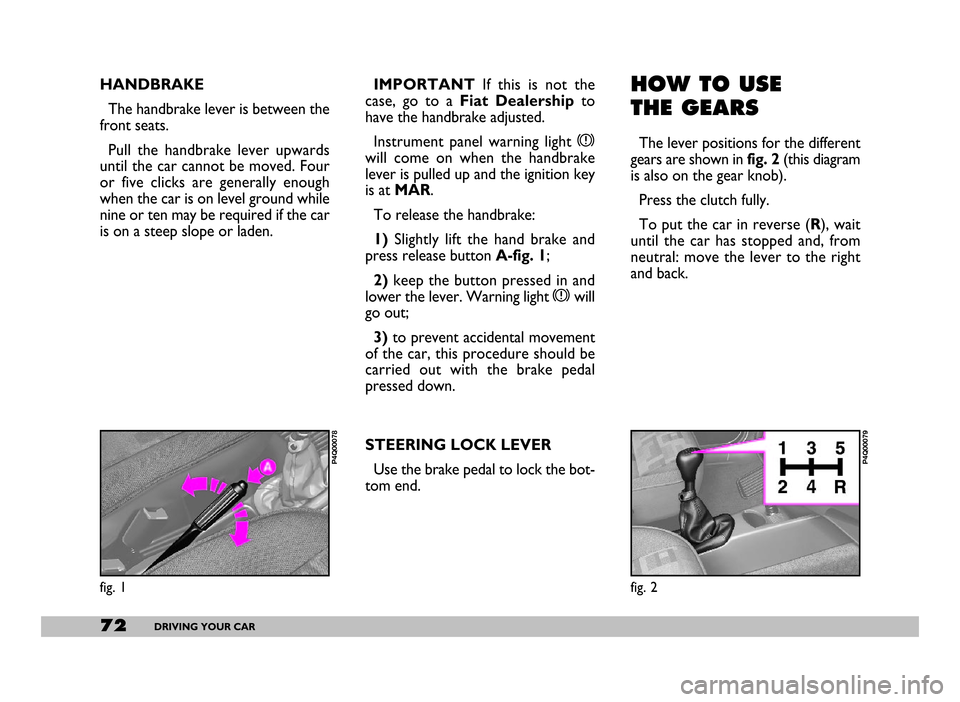
72DRIVING YOUR CAR
HANDBRAKE
The handbrake lever is between the
front seats.
Pull the handbrake lever upwards
until the car cannot be moved. Four
or five clicks are generally enough
when the car is on level ground while
nine or ten may be required if the car
is on a steep slope or laden. IMPORTANTIf this is not the
case, go to a Fiat Dealership to
have the handbrake adjusted.
Instrument panel warning light x
will come on when the handbrake
lever is pulled up and the ignition key
is at MAR.
To release the handbrake:
1)Slightly lift the hand brake and
press release button A-fig. 1;
2)keep the button pressed in and
lower the lever. Warning light xwill
go out;
3)to prevent accidental movement
of the car, this procedure should be
carried out with the brake pedal
pressed down.
STEERING LOCK LEVER
Use the brake pedal to lock the bot-
tom end. HOW TO USE
THE GEARS
The lever positions for the different
gears are shown in fig. 2(this diagram
is also on the gear knob).
Press the clutch fully.
To put the car in reverse (R), wait
until the car has stopped and, from
neutral: move the lever to the right
and back.
fig. 1
P4Q00078
fig. 2
P4Q00079
Page 74 of 154
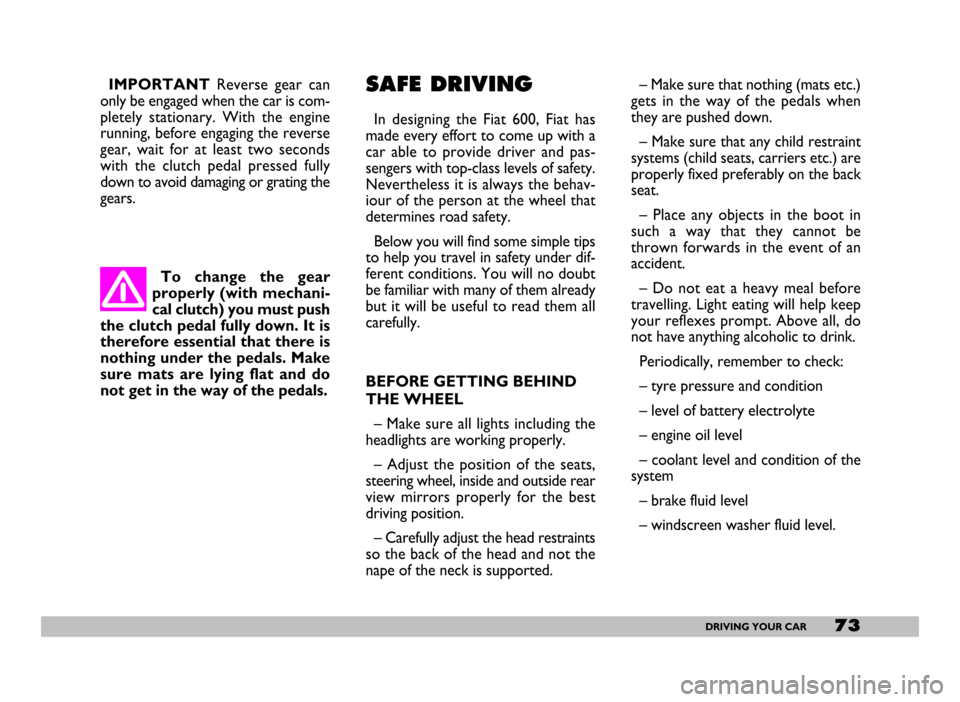
73DRIVING YOUR CAR
IMPORTANT Reverse gear can
only be engaged when the car is com-
pletely stationary. With the engine
running, before engaging the reverse
gear, wait for at least two seconds
with the clutch pedal pressed fully
down to avoid damaging or grating the
gears. SAFE DRIVING
In designing the Fiat 600, Fiat has
made every effort to come up with a
car able to provide driver and pas-
sengers with top-class levels of safety.
Nevertheless it is always the behav-
iour of the person at the wheel that
determines road safety.
Below you will find some simple tips
to help you travel in safety under dif-
ferent conditions. You will no doubt
be familiar with many of them already
but it will be useful to read them all
carefully.
BEFORE GETTING BEHIND
THE WHEEL
– Make sure all lights including the
headlights are working properly.
– Adjust the position of the seats,
steering wheel, inside and outside rear
view mirrors properly for the best
driving position.
– Carefully adjust the head restraints
so the back of the head and not the
nape of the neck is supported. – Make sure that nothing (mats etc.)
gets in the way of the pedals when
they are pushed down.
– Make sure that any child restraint
systems (child seats, carriers etc.) are
properly fixed preferably on the back
seat.
– Place any objects in the boot in
such a way that they cannot be
thrown forwards in the event of an
accident.
– Do not eat a heavy meal before
travelling. Light eating will help keep
your reflexes prompt. Above all, do
not have anything alcoholic to drink.
Periodically, remember to check:
– tyre pressure and condition
– level of battery electrolyte
– engine oil level
– coolant level and condition of the
system
– brake fluid level
– windscreen washer fluid level. To change the gear
properly (with mechani-
cal clutch) you must push
the clutch pedal fully down. It is
therefore essential that there is
nothing under the pedals. Make
sure mats are lying flat and do
not get in the way of the pedals.
Page 75 of 154
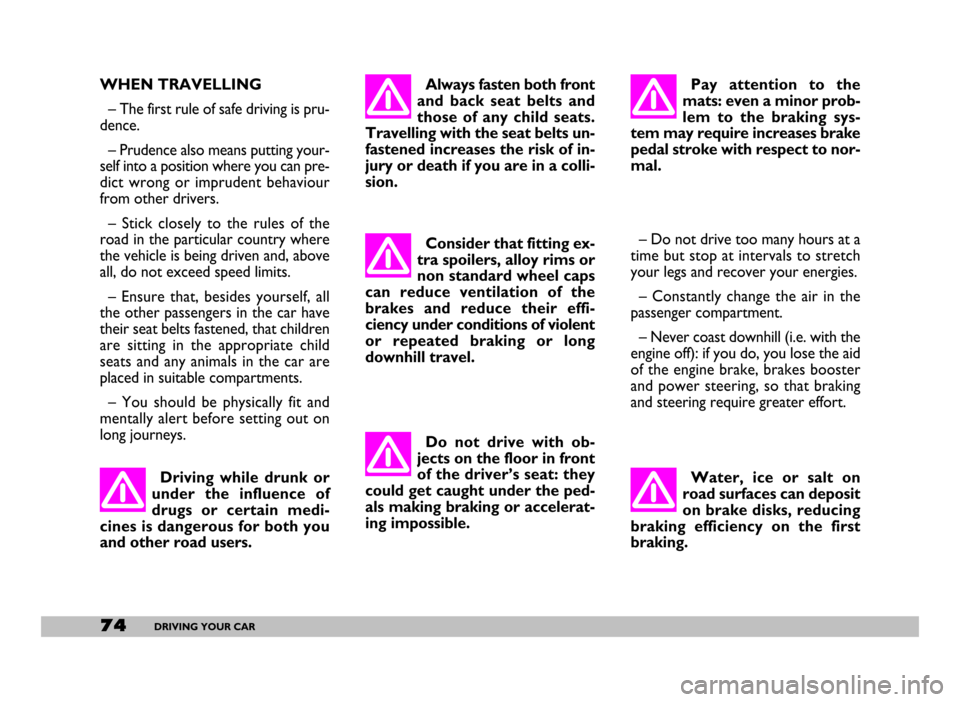
74DRIVING YOUR CAR
WHEN TRAVELLING
– The first rule of safe driving is pru-
dence.
– Prudence also means putting your-
self into a position where you can pre-
dict wrong or imprudent behaviour
from other drivers.
– Stick closely to the rules of the
road in the particular country where
the vehicle is being driven and, above
all, do not exceed speed limits.
– Ensure that, besides yourself, all
the other passengers in the car have
their seat belts fastened, that children
are sitting in the appropriate child
seats and any animals in the car are
placed in suitable compartments.
– You should be physically fit and
mentally alert before setting out on
long journeys. Always fasten both front
and back seat belts and
those of any child seats.
Travelling with the seat belts un-
fastened increases the risk of in-
jury or death if you are in a colli-
sion.
Driving while drunk or
under the influence of
drugs or certain medi-
cines is dangerous for both you
and other road users.
Water, ice or salt on
road surfaces can deposit
on brake disks, reducing
braking efficiency on the first
braking.
Consider that fitting ex-
tra spoilers, alloy rims or
non standard wheel caps
can reduce ventilation of the
brakes and reduce their effi-
ciency under conditions of violent
or repeated braking or long
downhill travel.
Do not drive with ob-
jects on the floor in front
of the driver’s seat: they
could get caught under the ped-
als making braking or accelerat-
ing impossible. Pay attention to the
mats: even a minor prob-
lem to the braking sys-
tem may require increases brake
pedal stroke with respect to nor-
mal.
– Do not drive too many hours at a
time but stop at intervals to stretch
your legs and recover your energies.
– Constantly change the air in the
passenger compartment.
– Never coast downhill (i.e. with the
engine off): if you do, you lose the aid
of the engine brake, brakes booster
and power steering, so that braking
and steering require greater effort.
Page 128 of 154
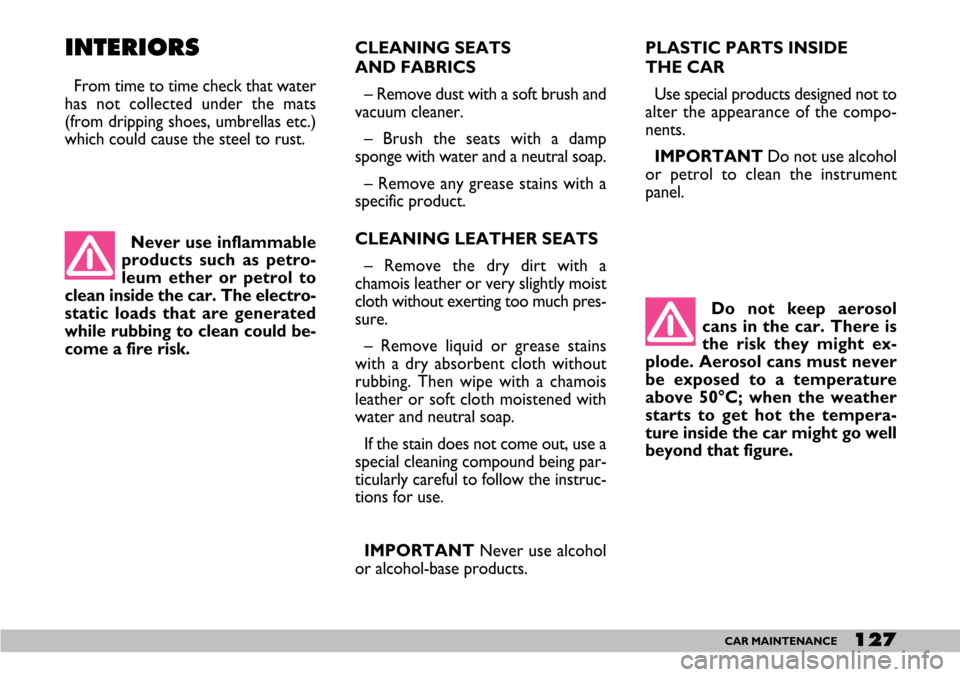
127CAR MAINTENANCE
CLEANING SEATS
AND FABRICS
– Remove dust with a soft brush and
vacuum cleaner.
– Brush the seats with a damp
sponge with water and a neutral soap.
– Remove any grease stains with a
specific product.
CLEANING LEATHER SEATS
– Remove the dry dirt with a
chamois leather or very slightly moist
cloth without exerting too much pres-
sure.
– Remove liquid or grease stains
with a dry absorbent cloth without
rubbing. Then wipe with a chamois
leather or soft cloth moistened with
water and neutral soap.
If the stain does not come out, use a
special cleaning compound being par-
ticularly careful to follow the instruc-
tions for use.
IMPORTANT Never use alcohol
or alcohol-base products.PLASTIC PARTS INSIDE
THE CAR
Use special products designed not to
alter the appearance of the compo-
nents.
IMPORTANT Do not use alcohol
or petrol to clean the instrument
panel.
Do not keep aerosol
cans in the car. There is
the risk they might ex-
plode. Aerosol cans must never
be exposed to a temperature
above 50°C; when the weather
starts to get hot the tempera-
ture inside the car might go well
beyond that figure.INTERIORS
From time to time check that water
has not collected under the mats
(from dripping shoes, umbrellas etc.)
which could cause the steel to rust.
Never use inflammable
products such as petro-
leum ether or petrol to
clean inside the car. The electro-
static loads that are generated
while rubbing to clean could be-
come a fire risk.
Page 150 of 154
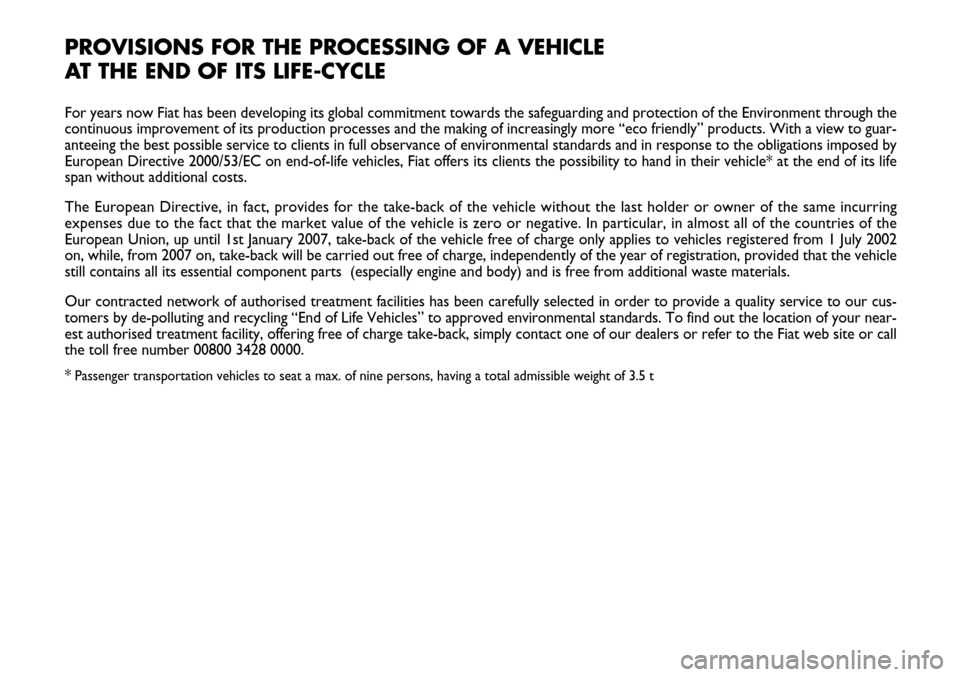
PROVISIONS FOR THE PROCESSING OF A VEHICLE
AT THE END OF ITS LIFE-CYCLE
For years now Fiat has been developing its global commitment towards the safeguarding and protection of the Environment through the
continuous improvement of its production processes and the making of increasingly more “eco friendly” products. With a view to guar-
anteeing the best possible service to clients in full observance of environmental standards and in response to the obligations imposed by
European Directive 2000/53/EC on end-of-life vehicles, Fiat offers its clients the possibility to hand in their vehicle* at the end of its life
span without additional costs.
The European Directive, in fact, provides for the take-back of the vehicle without the last holder or owner of the same incurring
expenses due to the fact that the market value of the vehicle is zero or negative. In particular, in almost all of the countries of the
European Union, up until 1st January 2007, take-back of the vehicle free of charge only applies to vehicles registered from 1 July 2002
on, while, from 2007 on, take-back will be carried out free of charge, independently of the year of registration, provided that the vehicle
still contains all its essential component parts (especially engine and body) and is free from additional waste materials.
Our contracted network of authorised treatment facilities has been carefully selected in order to provide a quality service to our cus-
tomers by de-polluting and recycling “End of Life Vehicles” to approved environmental standards. To find out the location of your near-
est authorised treatment facility, offering free of charge take-back, simply contact one of our dealers or refer to the Fiat web site or call
the toll free number 00800 3428 0000.
*
Passenger transportation vehicles to seat a max. of nine persons, having a total admissible weight of 3.5 t